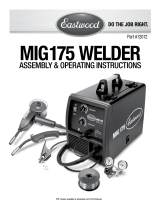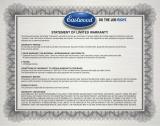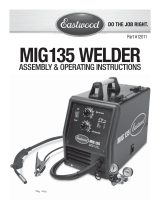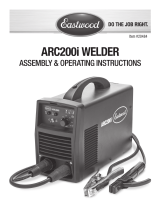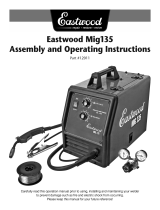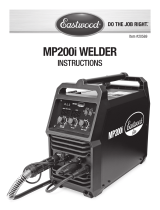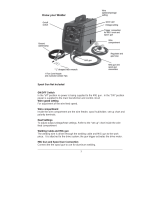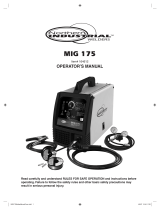Page is loading ...

MIG 250 WELDER
ASSEMBLY & OPERATING INSTRUCTIONS
Part #20279
PDF version available at eastwood.com/20279manual

2 Eastwood Technical Assistance: 800.544.5118 >> techelp@eastwood.com
STATEMENT OF LIMITED WARRANTY
The Eastwood Company (hereinafter “Eastwood”) warrants to the end user (purchaser) of all new welding and cutting equipment (collectively called the “products”) that it
will be free of defects in workmanship and material. This warranty is void if the equipment has been subjected to improper installation, improper care or abnormal operations.
WARRANTY PERIOD:
All warranty periods begin on the date of purchase from Eastwood. Warranty Periods are listed below, along with the products covered during those warranty periods:
3 Year Warranty on Material, Workmanship, and Defects:
• Eastwood MIG 250 Welder
Items not covered under this warranty: Contact tips, nozzles, wire, and ground clamp and cable.
All other components are covered by the warranty and will be repaired or replaced at the discretion of Eastwood.
2 Years:
• All Welding Helmets.
CONDITIONS OF WARRANTY TO OBTAIN WARRANTY COVERAGE:
Purchaser must fi rst contact Eastwood at 1-800-345-1178 for an RMA# before Eastwood will accept any welder returns.
Final determination of warranty on welding and cutting equipment will be made by Eastwood.
WARRANTY REPAIR:
If Eastwood confi rms the existence of a defect covered under this warranty plan, Eastwood will determine whether repair or replacement is the most suitable option
to rectify the defect. At Eastwood’s request, the purchaser must return, to Eastwood, any products claimed defective under Eastwood’s warranty.
FREIGHT COSTS:
The purchaser is responsible for shipment to and from Eastwood.
WARRANTY LIMITATIONS:
EASTWOOD WILL NOT ACCEPT RESPONSIBILITY OR LIABILITY FOR REPAIRS UNLESS MADE BY EASTWOOD. EASTWOOD’S LIABILITY UNDER THIS WARRANTY SHALL NOT
EXCEED THE COST OF CORRECTING THE DEFECT OF THE EASTWOOD PRODUCT. EASTWOOD WILL NOT BE LIABLE FOR INCIDENTAL OR CONSEQUENTIAL DAMAGES (SUCH
AS LOSS OF BUSINESS, ETC.) CAUSED BY THE DEFECT OR THE TIME INVOLVED TO CORRECT THE DEFECT. THIS WRITTEN WARRANTY IS THE ONLY EXPRESS WARRANTY
PROVIDED BY EASTWOOD WITH RESPECT TO ITS PRODUCTS. WARRANTIES IMPLIED BY LAW SUCH AS THE WARRANTY OF MERCHANTABILITY ARE LIMITED TO THE
DURATION OF THIS LIMITED WARRANTY FOR THE EQUIPMENT INVOLVED. THIS WARRANTY GIVES THE PURCHASER SPECIFIC LEGAL RIGHTS.
THE PURCHASER MAY ALSO HAVE OTHER RIGHTS WHICH VARY FROM STATE TO STATE.
SPECIFICATIONS
Rated Power Output No Load
Voltage
Power Input at
Rated Output
Duty Cycle Overall
Dimension
Weight
240 VAC 120 VAC 240 VAC 120 VAC 240 VAC 120 VAC
50 - 250 A 50 - 140 A 61V 47.3 A 20 A 60% @ 250 A 60% @ 140 A 30” x 15”
x 19.3”
76 lbs.
POWER SUPPLY
Wire Type Solid Steel Stainless Steel Flux Cored Aluminum
Diameter
.023 - .045"
(0.6 - 1.2mm)
.023 - .045"
(0.6 - 1.2mm)
.030 - .045"
(0.8 - 1.2mm)
.030 - .035"
(0.8 - .9mm)*
WELDING WIRE
* Wire sizes are for use with the Spool Gun, other sizes may be used with the standard torch and a Tefl on Liner.
When opening your Eastwood MIG 250, check to make sure all of the parts listed below are included:
(1) MIG 250 Welder
(1) MIG Gun
(1) Ground Cable with Clamp
(1) Shielding Gas Regulator
(1) Shielding Gas Hose
(1) Extra Contact Tips (2) .030"
(1) 8" Wire Spool Adapter
(1) Steel MIG Wire, ER70S-6, 2lb., 0.030"
(1) 120/240 VAC Adapter Cord
(1) Drive Roller
(1) Instruction Manual

To order parts and supplies: 800.345.1178 >> eastwood.com 3
READ INSTRUCTIONS!
• Thoroughly read and understand this instruction manual before using the welder.
SAFETY INFORMATION
ELECTRIC SHOCK CAN KILL!
• Improper use of an electric welder can cause electric shock, injury and death! Read all precautions described
in this manual to reduce the possibility of electric shock.
• Do not touch any electrical components that may be live.
• Separate yourself from the welding circuit by using insulating mats to prevent contact from the work surface.
• The welder power switch is to be in the OFF position and the power supply is to be disconnected when
performing any maintenance or consumable changes.
• Always wear dry, protective clothing and leather welding gloves and insulated footwear.
• Always operate the welder in a clean, dry, well ventilated area. Do not operate the welder in humid, wet,
rainy or poorly ventilated areas.
• Be sure that the work piece is properly supported and grounded prior to beginning an electric welding operation.
• The electrode and work (or ground) circuits are electrically “hot” when the welder is on. Do not touch these
“hot” parts with your bare skin or wet clothing.
• Disconnect from power supply before assembly, disassembly or maintenance of the torch or
contact tip or changing wire spools.
• Always attach the ground clamp to the piece to be welded and as close to the weld area as possible.
This will give the least resistance and best weld.
FUMES AND WELDING GASES CAN BE DANGEROUS!
• Do not breathe fumes that are produced by the welding operation. These fumes are dangerous.
Keep your head and face out of welding fumes. Do not breathe the welding fumes
• Always work in a properly ventilated area. Wearing an OSHA-approved respirator when welding is recommended!
• Never weld coated materials including but not limited to: cadmium plated, galvanized, lead based paints.
• Refer to the MSDS (Material Safety Data Sheet) for any consumables or materials used during welding for
additional safety instructions.
WELDING SPARKS CAN CAUSE FIRE OR EXPLOSION!
• Do not operate electric arc welder in areas where fl ammable or explosive vapors are present.
• Always keep a fi re extinguisher nearby while welding.
• Use welding blankets to protect painted surfaces, dash boards, engines, etc.
• Ensure power supply has properly rated wiring to handle power usage.
• Do not use on or near combustible surfaces.
• Remove all fl ammable items within 35 feet of the welding area.
• Do not weld frozen pipes.

4 Eastwood Technical Assistance: 800.544.5118 >> techelp@eastwood.com
ARC RAYS CAN BURN!
• Use a shield with the proper fi lter (a minimum of #11) to protect your eyes from sparks and the rays of the arc
when welding or when observing open arc welding (see ANSI Z49.1 and Z87.1 for safety standards).
• Use suitable clothing made from durable fl ame-resistant material to protect your skin. Protect nearby
individuals with a non-fl ammable barrier.
• Wear safety glasses under your welding helmet with side shields.
• If other persons are in the area of welding use welding screens to protect bystanders from sparks and arc rays.
HOT METAL WILL BURN!
• Electric welding operations cause sparks and heat metal to temperatures that will cause severe burns!
• Use protective gloves and clothing when performing any welding operations. Always wear long pants,
long-sleeved shirts and leather welding gloves.
• Make sure that all persons in the welding area are protected from heat, sparks and ultraviolet rays.
Use additional face shields and fl ame resistant barriers as needed.
• Never touch work piece until it has completely cooled.
ELECTROMAGNETIC FIELDS MAY BE DANGEROUS!
• The electromagnetic fi eld that is generated during arc welding may interfere with various electrical and electronic
devices such as cardiac pacemakers. Anyone using such devices should consult with their physician prior to
performing any electric welding operations.
• Exposure to electromagnetic fi elds while welding may have other health effects which are not known.
WELDING WIRE CAN BE DANGEROUS!
• Never point the welding gun at any part of the body, other people, or metal surfaces.
• Wear safety glasses and handle welding wire safety as it can be sharp and cause injury.
MOVING PARTS CAN BE DANGEROUS!
• Use care when working near the drive motor assembly as it can pinch.
• Do not put fi ngers or other body parts between moving parts.
FLYING METAL CHIPS CAN CAUSE INJURY!
• Welding, brushing, hammering, chipping, and grinding can cause fl ying metal chips and sparks.
• To prevent injury wear approved safety glasses.
MAGNETIC FIELDS CAN AFFECT PACEMAKERS!
• Any user with a pacemaker should consult their doctor before use.
• Anyone with a pacemaker should stay away from any electric welding before consulting a doctor.
SAFETY INFORMATION
NOTICE!
• Do not touch the contact tip with the unit turned “ON”. Turn the unit “OFF” before changing tips
or cleaning the nozzle.

11 12
22
To order parts and supplies: 800.345.1178 >> eastwood.com 5
COMPONENTS & CONTROLS
1. Ground Cable Connection
2. MIG/Spool Gun Connection
3. MIG/Spool Gun Switch Connection
4. Power Switch
5. Voltage Control
6. Wire Speed Control
7. MIG/Spool Gun Selector Switch
8. Shielding Gas Regulator
9. Shielding Gas Hose
10. Shielding Gas Input
11. Nozzle
12. Contact Tip
13. Wire Pressure Adjuster
14. Rocker Arm
15. Drive Roller
16. Drive Roller Retaining Knob
17. Welding Gun Tensioner
18. Positive Terminal
19. Negative Terminal
20. Wire Spool Tension Screw
21. 8” Wire Spool Adapter
22. MIG Gun
23.120 to 240 VAC Adaptor Cord
24. Quick Feed Switch
9
18
10
22
6
2
1
20
4
7
5
21
8
19
13
12
15
3
24
17
16
15
14
23

6 Eastwood Technical Assistance: 800.544.5118 >> techelp@eastwood.com
FIG. D
FIG. D
CONNECTING THE WELDER TO A POWER SOURCE
For use on 240 VAC power, the Eastwood MIG 250 Welder requires a dedicated 240 VAC, 50 Amp,
50-60Hz grounded outlet protected by a circuit breaker with a NEMA 6-50 Receptacle. If using
an extension cord, use a minimum 6 AWG cord for up to 25 feet.
For use on 120 VAC power, the Eastwood MIG 250 Welder requires a dedicated 120 VAC,
20 Amp, 50-60Hz grounded outlet protected by a circuit breaker. If using an extension cord, use
a minimum 12 AWG cord for up to 25 feet. When using the welder on 120 VAC input power, do
not turn the voltage setting past the indicated marking, or the amperage draw will exceed
20 Amps, which will trip a circuit breaker.
SET UP & OPERATION
INSTALLING THE WELDING GUN
1. Open the side door of the welder and loosen the Welding Gun Tensioner
Thumb Screw (Fig. A).
2. Slide the brass body of the Welding Gun through the front of the Welder
into the Welding Gun Power Connection. Insert until it bottoms against
the Drive Motor Assembly or a gas leak may occur.
3. Tighten the Welding Gun Tensioner Security.
4. Connect the Trigger Plug on the Welding Gun to the Trigger Plug
Connection on the Welder (Fig. B).
5. Set the MIG/Spool Gun Selector Switch to MIG.
INSTALLING THE GROUND CLAMP
1. Locate the Ground Cable and Clamp.
2. The Ground Cable Connection is located at the far right of the Front Panel.
With the Key on the Connector in the 12 O’clock position, insert
the Connector and turn 180° clockwise to lock in the Connector (Fig. B).
CHANGING POLARITY (FLUX CORE WIRE)
UNPLUG UNIT FIRST!
The Eastwood MIG 250 comes set up to MIG weld with solid wire.
To weld without gas using fl ux-cored wire, the polarity must be changed.
1. Turn OFF and disconnect welder from power.
2. Remove the knobs on the Negative and Positive Power Terminals (Fig. C).
3. Remove the power leads from the studs.
4. Install the Positive lead from the Torch onto the Negative (-) Stud
and replace the Black knob (Fig. D).
5. Install the Negative lead from the Ground Cable onto the Positive (+)
Stud and replace the Red knob (Fig. D).
FIG. C
FIG. C
FIG. A
FIG. A
FIG. B
FIG. B
Polarity for
MIG Welding
Polarity for
Flux-Cored
Welding
6-50 Receptacle
Welding Gun
Tensioner
Welding Gun
Power
Connection
Ground Cable
Connection
Trigger
Connection

To order parts and supplies: 800.345.1178 >> eastwood.com 7
INSTALLING SHIELDING GAS SUPPLY
A shielding Gas bottle is not included with your Eastwood MIG 250 but is necessary for welding using solid wire.
Eastwood recommends the following shielding gases or consult your wire manufacturer for their recommendations:
1. Place the MIG 250 in its dedicated area or on a welding cart.
2. Secure your shielding gas bottle to a stationary object or mount to
your welding cart.
3. Remove the cap from the shielding gas bottle.
4. Insert the large brass male fi tting on the Shielding Gas Regulator onto to
female fi tting on the shielding gas bottle. NOTE: Do not use white Tefl on
tape on this connection as it is a compression fi tting and does not require
it. If you have leaks, check the tank and regulator fi tting for dirt or burrs.
5. Tighten the fi tting with a wrench until snug, do not over tighten.
6. Connect either end of the gas line to the fi tting on the rear of the MIG 250
and wrench tighten until snug (Fig. E).
7. Check the gas line for leaks by slowly opening the valve on the gas bottle.
When welding, the valve on the bottle should be open all of the way.
FIG. x
FIG. x
Flow
Regulator
Hose feeds
to gas input
Valve
Bottle
Pressure
Gauge
Gas Flow
Output
Gauge
Wire Type Shielding Gas
Steel (short circuit) 75% Argon / 25% CO
2
Stainless Steel 90% He / 7.5% Ar / 2.5% CO
2
(Tri-Mix)
Aluminum 100% Argon
CHANGING THE DRIVE ROLLER
The MIG 250 is set up to use 0.030" (0.8mm) wire. If a different size wire is
used, the drive roller needs to be changed. Adjust the drive roller according to
the following procedure:
UNPLUG UNIT FIRST!
1. Open the side door of the welder to access the drive motor (Fig. F).
2. Lift the Pressure Adjuster out of the way and move the Tension Arm
away from the Drive Roller.
3. Remove the Drive Roller Retaining Knob by turning the knob
counterclockwise.
4. Remove the Drive Roller by sliding the outer drive roller ring off the
drive roller hub.
5. Install the drive roller in the orientation so that the size of the wire you
are using is facing you on the side of the drive roller.
6. Reinstall the Drive Roller Retaining Knob and fi nger tighten.
7. Put the Tension Arm back in place and reset the Pressure Adjuster.
FIG. E
FIG. E
FIG. F
FIG. F
Pressure
Adjuster
Drive
Roller
Retaining
Knob
Tension
Arm
Drive
Roller

8 Eastwood Technical Assistance: 800.544.5118 >> techelp@eastwood.com
INSTALLING WELDING WIRE
The MIG 250 can be used with either a 4" or 8" Wire Spool. To use the larger 8" spool an
included adapter is necessary.
To install a 4" Wire Spool:
1. Open the door of the welder and remove the wing nut, spacer and 8" Spool Adapter
from the wire Spool Spindle.
2. Slide the 4" Wire Spool onto the spindle and reinstall the spacer and wing nut (Fig. G).
Place the Spool Adapter in a safe place for if it is needed in the future.
3. To set the tension on the wire, tighten the wing nut till there is a slight resistant to
spinning the wire spool. If the tension is set too loose the wire spool will spin on the
shaft and un-spool the wire. If the tension is too tight, the drive roller will have issues
pulling the wire and feeding issues will occur.
To install an 8" Wire Spool:
1. Open the door of the welder and be sure the 8" spool adapter is installed on the spindle.
If it has been previously removed, reinstall it (Fig. H).
2. Align the pin on the spool adapter with the hole on the wire spool and slide the spool
over the adapter making sure the pin on the adapter goes into the hole in the spool.
3. To set the tension on the wire, tighten the wing nut until there is a slight resistance to
spinning the wire spool on the spindle. If the tension is set too loose the wire spool will
spin on the shaft and un-spool the wire. If the tension is too tight, the drive roller will
have issues pulling the wire and feeding issues will occur.
FEEDING WELDING WIRE
1. Turn Power Switch off and disconnect welder from power supply.
2. Unlock the Pressure Adjuster on the Wire Tensioner by pushing it
towards the front of the welder.
3. Lift up the Rocker Arm so that it is out of the way.
4. Ensure that the Drive Roller size is appropriate to the welding wire
size; see page 7 on how to change the Drive Roller.
5. Pull out the welding wire from the welding wire spool carefully.
NOTE: DO NOT LET GO OF THE WIRE PRIOR TO STEP 5 OR
THE SPOOL WILL UNRAVEL RENDERING IT USELESS.
6. Cut off the small piece of the curved segment at the front of
welding wire and straighten the welding wire approximately
3.0" long.
7. Thread the welding wire through the guide pipe and over the wire feed roller and into the torch hole.
8. Reattach the rocker arm and reset the Pressure Adjuster on the wire feeder.
9. Remove the contact tip and nozzle from the MIG Gun.
10. Turn on the machine.
11. With the gun pointed away from you and others, depress the Quick Feed button to feed the wire through the gun cable. Stop feed-
ing the wire once the wire has come a few inches out of the end of the MIG Gun. NOTE: Watch the drive roller to see if any slipping
is occurring between the roller and the wire – if so turn the machine off and tighten the Pressure Adjuster 1⁄2 turn and test again.
FIG. G
FIG. G
FIG. H
FIG. H
Wing Nut
Spacer
FIG. I
FIG. I
Pressure
Adjuster
Wire
Tensioner

To order parts and supplies: 800.345.1178 >> eastwood.com 9
INSTALLING & FEEDING WELDING WIRE
WITH A SPOOL GUN
1. Turn off welder and unplug from power source.
2. Set the switch above the drive motor to the spool gun setting.
3. Remove the thumb screw and clear plastic wire spool cover.
4. Remove the thumb screw and spring Tensioner that holds the wire spool on.
5. Place wire spool on spindle and replace the thumb screw with spring Tensioner and tighten till the point that the spool has some
tension on it.
6. Loosen the Brass Tensioner Thumb Screw until it is possible to feed the welding wire through the drive roller grooves.
7. Feed the wire by hand from the spool into the inlet guide, past the drive rollers and into the wire inlet.
8. Tighten the Brass Tensioner Thumb Screw until it applies light pressure onto the welding wire. If this is too tight, it will deform the
wire and cause feeding issues. If it is too loose, the drive roller will slip on the wire.
9. Remove the nozzle and contact tip.
10. Replace the wire spool cover.
11. Plug in welder to your power source and turn on the welder.
12. Trigger the Spool Gun to feed the wire and adjust the Brass Tensioner Thumb Screw so that the wire does not slip.
13. Replace Contact Tip and Nozzle.
INSTALLING A SPOOL GUN (SOLD SEPARATELY)
1. Turn off welder and unplug from power source.
2. Switch the selector switch to the Spool Gun position.
3. Open the side door of the welder and loosen the
Torch Tensioner.
4. If the standard welding gun is installed remove it and its
associated connector.
5. Slide the brass body of the Spool Gun in through the front
of the unit in the designated socket. Be sure to insert until it
bottoms against the drive assembly or a gas leak may occur.
6. Connect Gun Trigger metal plug on the front of the welder.
7. Tighten the Torch Tensioner fi nger tight.
Gun Trigger
Metal Plug
Brass Tensioner
Thumb Screw
Spring
Tensioner
Inlet Guide
Wire Inlet

10 Eastwood Technical Assistance: 800.544.5118 >> techelp@eastwood.com
DUTY CYCLE
The rated Duty Cycle refers to the amount of welding that can be done within an amount of time. It is easiest to look at your welding
time in blocks of 10 Minutes and the Duty Cycle being a percentage of that 10 Minutes. If welding at 250 Amps with a 60% Duty Cycle,
within a 10 Minute block of time you can weld for 6 Minutes with 4 Minutes of cooling for the welder. If the duty cycle is exceeded and
the breaker is tripped, allow the unit to cool for a minimum of 15 Minutes. To increase the Duty Cycle, you can turn down the Voltage
Output control.
MIG WELDING OPERATION
Your Eastwood MIG 250 can be used to form a large number of different joints and welds all of which will require practice and testing
before using on an actual project piece. The following welding process is a baseline to help get you started:
1. Refer to the ‘Suggested Settings’ chart which is located inside the side door of your Eastwood MIG 250, as well as below in the
instruction manual. From the chart select your baseline starting point for the recommended settings described in the chart.
2. Change the output polarity if necessary according to the welding wire’s specifi cations. This welder comes set up to use solid
MIG wire, but if using Flux-cored wire, the polarity will need to be changed.
3. Connect your ground clamp to the work pieces that are to be welded. Make sure the ground clamp contacts are placed on a
clean piece of metal free of paint, grease, rust, oils, etc. It is recommended to place your ground clamp as close to the weld
area as possible.
4. Assess your weld area and make sure the welding area is also cleaned of any paint, grease, rust, oils, etc.
5. Plug in the welder and switch to the ‘ON’ position.
6. Open your gas valve on the bottle and adjust the fl ow rate if necessary.
7. Depress the torch trigger pointing the welding gun away from your body and then let go of the trigger and cut the wire back
to ~1/4" stick out length.
8. Wearing your welding helmet, gloves and long sleeve shirt and pants, put the end of the wire sticking out of the gun into the
joint to be welded.
9. Position the welding gun so that it is perpendicular to the base metal with ~20° tilt back.
10. Depress the trigger to start the wire feed which starts the arc. NOTE: A push, perpendicular or drag technique can be used
to weld the pieces together; the type used depends on the type of joint as well as other infl uential conditions.
11.
Once you depress the trigger and the arc has started, you will notice a molten puddle will form; this puddle is the weld bead and will
follow the motion of the welding torch. Watching the size of the puddle dictates how fast you should be moving with the torch. If you
burn through the material, you are either moving to slow or you need to make some adjustments to the welder settings. If you’re not
penetrating the base metal, you’re either moving too fast or you need to make adjustments to the welder settings.
12. Release the trigger on the welding gun to stop the weld.
13. After fi nished welding, close the valve completely on the Shielding Gas Bottle.

To order parts and supplies: 800.345.1178 >> eastwood.com 11
SPOOL GUN WELDING OPERATION
Your Eastwood MIG 250 can be used to weld aluminum utilizing a spool gun, which can be purchased from Eastwood. To utilize the
Spool Gun, you will also need to purchase a cylinder of 100% Argon gas from your local welding supplier. The following welding process
is a baseline to help you get you started:
1. Refer to the ‘Suggested Settings’ chart which is located inside the side door of your welder. Select your baseline starting point
for the recommended settings described in the chart.
2. Ensure that the polarity is confi gured for DCEP welding.
3. Set the process selector switch to ‘MIG’.
4. Set the MIG/Spool Gun Selector Switch to ‘Spool Gun’.
5. Connect your ground clamp to the work pieces that are to be welded. Make sure the ground clamp contacts are placed on a
clean piece of metal free of paint, grease, rust, oils, etc. It is recommended to place your ground clamp as close to the weld
area as possible.
6. Assess your weld area and make sure the welding area is also cleaned of any paint, grease, rust, oils, etc. Aluminum has a
layer of oxide on the surface that should be removed prior to welding.
7. Plug in the welder and switch to the ‘ON’ position.
8. Open your gas valve on the bottle and adjust the fl ow rate if necessary.
9. Depress the spool gun trigger for a few seconds pointing the welding gun away from your body and then let go of the trigger
and cut the wire back to ~3/4" stick out length.
10. Wearing your welding helmet, gloves and long sleeve shirt and pants, put the end of the wire sticking out of the spool gun into
the joint to be welded.
11. Position the welding gun so that it is perpendicular to the base metal with 10-15° angle in the direction of push travel.
12. Depress the trigger to start the wire feed which starts the arc. NOTE: When welding aluminum with a Spool Gun, it is
recommended to use a push technique. Using a drag technique will result in poor, dirty welds.
13. When welding aluminum a spray arc transfer is preferred rather than short arc transfer that can be more commonly used on
steels. This method involves using a longer wire stick out (~3/4"). When the welder settings and technique have been dialed
in, the spray arc transfer should create a hissing sound and little or no spatter. Once positioned, the trigger can be pulled and
the weld started.
14. Release the trigger on the welding gun to stop the weld.
15. After fi nished welding, close the valve completely on the Shielding Gas Bottle.

12 Eastwood Technical Assistance: 800.544.5118 >> techelp@eastwood.com
TYPES OF WELD JOINTS
1. Butt Weld is a joint between two pieces that are laying in
the same direction.
3. Edge Weld is a joint between two pieces where the
edges are being joined.
5. Tee Weld is a joint between two pieces where one is
perpendicular to the other.
Weld
isajointbetweentwopieceswhere
2. Corner Weld is a joint between two pieces that meet at
or near perpendicular at their edges.
4. Lap Weld is a joint between two overlapping pieces.
6. Plug Weld is a joint which joins two overlapping pieces
by fi lling in a hole punched in the top piece.

To order parts and supplies: 800.345.1178 >> eastwood.com 13
TROUBLESHOOTING

14 Eastwood Technical Assistance: 800.544.5118 >> techelp@eastwood.com
TROUBLESHOOTING

To order parts and supplies: 800.345.1178 >> eastwood.com 15

© Copyright 2014 Easthill Group, Inc. Instruction part #20279Q Rev. 10/14
If you have any questions about the use of this product, please contact
The Eastwood Technical Assistance Service Department: 800.544.5118 >> email: techelp@eastwood.com
PDF version of this manual is available online >> eastwood.com/20279manual
The Eastwood Company 263 Shoemaker Road, Pottstown, PA 19464, USA
US and Canada: 800.345.1178 Outside US: 610.718.8335
Fax: 610.323.6268 eastwood.com
/
